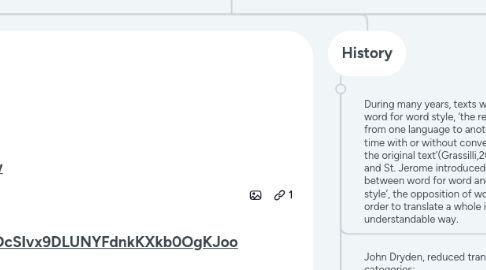
1. What is translation?
1.1. ' Translation refers to the process of, or the product resulting from, transferring or mediating written text(s) of different lengths (ranging from words and sentences to entire books) from one human language to another’ (Colina, 2015, p. 3).
1.1.1. The process of translation involves an original text called Source Text(ST) in an original Language, source Langue(SL) and the translated text called target text(TT) in a Target Langue(TL).
2. History
2.1. During many years, texts were translated in a word for word style, ‘the rendering of text from one language to another one word at a time with or without conveying the sense of the original text’(Grassilli,2016), until Cicero and St. Jerome introduced the difference between word for word and ‘sense for sense style’, the opposition of word for word in order to translate a whole idea in an understandable way.
2.2. John Dryden, reduced translation into three categories: -'metaphrase': It is literal translation, Word for word. 'paraphrase': It is kind of sense for sense translation. 'imitation': It is like adaptation.
2.3. Alexander Tyler in 1797, launched 'Essay on the principles of translation' explaining three general rules: 1) The translation should give a complete transcript of the ideas of the original work. 2)The style and manner of writing should be of the same character with that of the original. 3)The translation should have all the ease of the original composition.
3. Translation studies
3.1. 'Translation Studies is an academic discipline that studies the theory and practice of translation.It is, by nature, a multilingual but also interdisciplinary field of study since establishes relationships with with linguistics, cultural studies, philosophy, the informationsciences, and so forth'(Garcia de Toro, 2008)
3.1.1. In 1972 James Holmes, in his framework 'The name and nature of Translation Studies' explained with a conceptual map what translation studies covers:
3.1.1.1. Pure area; it is divided for theoretical and descriptive areas.
3.1.1.1.1. Theoretical
3.1.1.1.2. Descriptive
3.1.1.2. Applied Area:
3.1.1.2.1. It is divided in three areas:
4. Translator
4.1. The principal duties of a translator are:
4.1.1. - Read and understand the text to be translated.
4.1.2. -Preserve the style, voice, tone ans structure of the source text, among others.
4.1.3. -One duty that has not an impact as it should is ethics.
4.1.3.1. Inside the ethic area, we found accountability ( 'It requires every professional and every citizen to demonstrate that he or she is cognizant of the impact of their behaviour on others, aware of its legal implications, and prepared to take responsibility for its consequences') (Baker,2015). As the example of Mohamed yousry who was arrested for translated a letter which was released to the press.
4.1.3.1.1. What is ethical? In order to understand what ethical is, Baker introduce Deontological and teological approaches: 'Deontological models define what is ethical by reference to what is right in and of itself, irrespective of consequences, and are rule-based..... Teleological approaches, on the other hand, define what is ethical by reference to what produces the best results. Utilitarianism … is a teleological theory that is more concerned with consequences than with what is morally right per se'(Baker, 2015).
5. Free vs literal translation
5.1. Free translation is the equivalent of sense for sense translation, and literal translation is the equivalent of word for word translation.
5.1.1. The big question, free or literal translation? 'It is believed by most linguists that 70% of the sentences in every language can be rendered in translation using the literal method, even dealing with difficult texts'(Lacandazo, 2013)
5.1.1.1. .
5.1.1.1.1. The truth is that both styles can be useful depending on the context. Literal translation is normally used in medical, scientific, law fields. On the other hand, free translation is normally used in poetry, literature, among others. Also it depends in the preference of the translator.
